Waste Conversion: Energy from Waste Plant in Winterthur, Switzerland a Model for Organic Waste Management and Biomethane Production
Processing 22,000 tons of kitchen and green waste annually from more than 135,000 inhabitants in the communities of Winterthur and Frauenfeld, Switzerland near Zurich, the new waste-from-energy (EfW) plant integrates leading technologies of Kompogas® dry anaerobic digestion and BioMethan amine scrubbing from Hitachi Zosen Inova, to generate 39.9 million standard cubic feet (SCF) of carbon-neutral biomethane per year, plus high-grade liquid fertilizer and compost.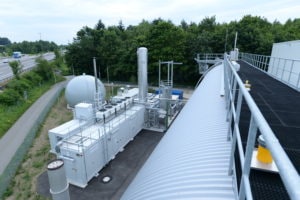
Jim McMahon
In 2011, the City of Winterthur, Switzerland launched a 2050 energy policy, which included a long-term reduction in greenhouse gas emissions equivalent to 2.2 tons of CO2 per person per year, and corresponding measures to promote sustainable energy technologies. To achieve this objective, the city formed a partnership with the adjoining community of Frauenfeld, and Axpo Kompogas AG (Axpo) – a leading owner and operator of biogas plants in Switzerland – to construct and operate a new dry anaerobic digestion plant for the processing of the communities’ organic waste, and production of carbon-neutral biomethane for distribution into the natural gas grid.
The plant at Winterthur, commissioned in spring 2014, not only produces biomethane, but also recovers and recycles the nutrients contained in the organic material. From the plant’s digestate, top-grade solid compost is produced, which is made available to nurseries, farmers and market gardens. The process also produces liquid digestate, which is distributed for agricultural use as a certified organic liquid soil conditioner.
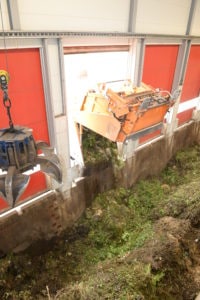
The plant was designed to make a significant contribution to long-term environmental and climate protection efforts by reducing CO2 emissions, and by reducing the need for natural gas through drilling, thereby offsetting fossil carbon emissions.
“The production of biomethane as a fuel, and digestate as a natural fertilizer, plays a critical role in the efforts of the communities of Winterthur and Frauenfeld to realize both environmental and economic benefits,” said Michael Oertig, Technical Director with Axpo Kompogas AG. “The plant, currently operating at 80 percent capacity, is processing 22,000 tons of kitchen and green waste every year, from more than 135,000 inhabitants in the Winterthur and Frauenfeld areas. It is then generating 39.9 million standard cubic feet (SCF) of carbon-neutral biomethane*. and 20,000 tons of natural, high-grade, solid and liquid fertilizer each year.”
(*39.9 million standard cubic feet (SCF) of carbon-neutral biomethane is equal to 277,200 diesel gallons equivalent (DGE).
To feed the Winterthur plant, organic waste, in the form of lawn and tree cuttings, and fruit and vegetable waste, is recovered from source segregated organic (SSO) waste. When households or restaurants produce organic waste it is collected separately from residual waste. This ensures that the source segregated organics do not come into contact with any contaminants that might be in the residual waste.
Winterthur’s Integrated System of Dry Anaerobic Digestion and Biomethane Amine Scrubbing Processes
The Winterthur plant was designed with a unique integration of the Kompogas® dry anaerobic digestion process, combined with BioMethan amine scrubbing technology. This effectively made the Kompogas/BioMethan combined processes the only dry anaerobic digestion and biomethane amine scrubbing technologies available from one single-source – Hitachi Zosen Inova – as a fully-integrated and completely-automated system. Hitachi Zosen Inova is a global EPC (engineering, procurement, construction) contractor for thermal and biological energy-from-waste (EfW) plants.
“The combination of technologies from a single EPC supplier is quite unique,” added Oertig. “Normally, these projects would require anaerobic digestion and biomethane scrubbing systems from two different suppliers. HZI provides the production of biogas and the purification of biomethane in one fully-integrated system.”
Kompogas Continuous Dry Anaerobic Digestion Process
Winterthur’s digester is a full-steel, 100 foot long, Kompogas model PF1500 system. Its process is based on the continuous dry fermentation of organic waste in an anaerobic environment, using a horizontal plug-flow digester. The Kompogas system is proven technology that has been installed in more than 80 facilities worldwide.
After receiving the biomass into the Winterthur plant, the organic waste is unloaded in a pit bunker using an odor trap. An automated crane is utilized to convey the organic mass in the pre-treatment process before entering the digester. Employing a pit bunker and crane enables fully automated feeding of the Kompogas plant, even at night and weekends. To prepare for anaerobic digestion, a shredder chops the organic matter into small pieces which then are sieved to a maximum particle size of about 2 inches to remove impurities such as stones, plastics and metal. The prepared biomass is then automatically conveyed to the digester feed-in point. 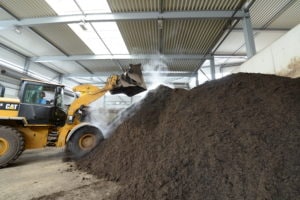
The organic material is transported inside the digester, via plug-flow process, with the material moving horizontally through the system. A slowly-turning agitator ensures that the substrate is optimally mixed within the digester, and the biogas bubbles are permitted to vent for high-yield formation of methane.
“Digestate, rich in thermophilic microorganisms, is added to activate and accelerate the anaerobic digestion process,” said Markus Burri, Process Engineer with Hitachi Zosen Inova. “The addition of process water creates the optimal consistency for decomposition, with humidity residing around 70 percent. A specially developed heating system regulates the temperature during processing at 131° F (55° C). The thermophilic microorganisms decompose the organic matter and produce carbon-neutral biogas.”
“The digester’s very efficient microorganism environment optimizes the different steps of biomass degradation throughout the process, making for very stable microbiology inside the reactor,” added Burri. “The process recirculates about 33 percent of the digestate output back upfront into the digester to keep microorganisms feeding the process. This facilitates high bioprocessing efficiency within the system.”
Anaerobic digestion is a multi-step biological and chemical process with four fundamental steps that include hydrolysis, acidogenesis, acetogenesis and methanogenesis. Throughout this entire process, large organic polymers that make up biomass are broken down into smaller molecules by chemicals and microorganisms. Upon completion of the anaerobic digestion process, the biomass is converted into biogas, namely methane (CH4) and carbon dioxide , as well as into digestate – liquid and solid.
An anaerobic digestion retention period of 14 days at 131° F (55° C) ensures that spores and bacteria are eliminated. The digestate is completely sanitized during processing, and the biogas potential is fully exploited by the time the substrate comes out of the digester.
“Kompogas is the most efficient process for producing the highest gas yield out of one ton of input material,” explained Oertig. “It is reliable, and biologically very strong. All other digester systems have a lower gas yield.”
The Kompogas process at Winterthur makes maximum use of the organic waste’s energy potential, producing up to 600 kilowatt-hours of energy per ton of waste, depending on the type of biowaste used.
BioMethan Upgrade with Amine Scrubbing
The raw biogas produced in the Winterthur digester, which is approximately 52 percent methane, is collected, and pre-cleaned with activated carbon to remove hydrosulfites, before being fed into the BioMethan gas treatment plant for heat-driven amine scrubbing. BioMethan separates the CO2 and upgrades the CH4 to natural gas quality – so called biomethane. The biomethane is then compressed to 3 bar and fed into the municipal gas grid.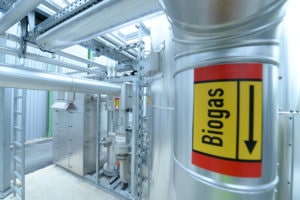
“BioMethan technology is a highly efficient and economical process, producing methane purity of up to 99 percent, and methane slip of below 0.1 percent,” continued Burri. “The electricity demand for the process is 0.1 kWh per cubic meter of biogas. The heat demand is 0.6 kWh per cubic meter of biogas.”
The modularity of the BioMethan technology permitted configuration specifically to the requirements of Winterthur‘s Kompogas system. “HZI prefabricated Winterthur‘s BioMethan upgrade system at its manufacturing facility, before installing the system on-site, completing the electrical installations, sensor wiring, and process control installation,” continued Oertig. “Automation testing and visualization of the process was also completed in-house. This enabled a smooth and timely commissioning on-site.”
Waste to Resource
After exiting the digester, two sieve screw presses are used to separate the fermented residue from the digester into a liquid and a solid digestate.
The press cake is stored and further stabilized in subsequent composting. This process allows the material to mature into top-grade compost that is collected by nurseries, market gardens and farmers for use as fertilizer. Part of the press juice is fed back into the digester to directly initiate the fermentation process. The remainder is used in agriculture as certified organic liquid fertilizer.
Conversion of biowaste to usable digestate and energy not only decreases the volume of waste, it saves natural resources such as land and water. It also protects the air and climate because it reduces the greenhouse gases coming from landfill – effectively delivering a closed, and environmentally friendly, carbon cycle.
For residents of Winterthur and Frauenfeld, who are largely environmentally conscious, biomethane is a desired energy preferred over natural gas. Comparatively, for the same amount of heat or electricity generated, the biomethane produced at the Winterthur plant produces 80 percent less greenhouse gas emissions compared to burning natural gas as a fossil fuel. “Recovery of digestate and energy from waste, using thermal and biological waste treatment, is an important part of waste management,” said Oertig. “It is a movement away from wasted resources, to the utilization of waste as a resource. Our new plant at Winterthur embraces this concept. It focuses on maximizing use of biomass resources, and minimizing the adverse impact on the environment.”
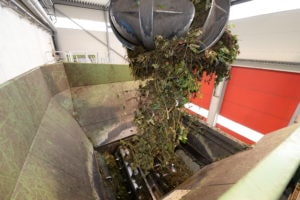
Axpo Kompogas AG, founded in 1989, is a leading owner and operator of 15 biogas plants in Switzerland. The company produces both carbon-neutral biomethane and electricity, plus high-grade liquid fertilizer and natural compost from fermenting organic waste. It engages in energy generation for cities and communities, industries, commerce and private households. Axpo Kompogas AG is a subsidiary of Axpo Group, a pioneer in the field of renewable energy, and the largest producer of renewable energy in Switzerland. Axpo Group operates hydroelectricity, nuclear, wind power and biogas generation plants throughout Europe. It reliably produces, trades and sells energy for over 3 million people and thousands of companies in Switzerland, and more than 30 European countries. For more information, contact Michael Oertig, Technical Director, at [email protected] or visit www.axpo.com.
Zurich-based Hitachi Zosen Inova (HZI) is a global leader in energy from waste (EfW), operating as part of the Hitachi Zosen Corporation Group. Formed from the former Von Roll Inova, HZI acts as engineering, procurement and construction (EPC) contractor delivering complete turnkey plants and system solutions for thermal and biological EfW recovery. Its solutions are based on efficient and environmentally sound technology, are thoroughly tested, can be flexibly adapted to user requirements, and cover the entire plant life cycle. The company’s customers range from experienced waste management companies to up-and-coming partners in new markets worldwide. HZI’s innovative and reliable waste and flue gas treatment solutions have been part of some 570 reference projects delivered since 1933. HZI also counts more than 130 references in anaerobic digestion and gas upgrading. For more information, contact Markus Stangl, Chief Executive Officer, Hitachi Zosen Inova U.S.A. LLC, at (678) 987-2575, via e-mail at [email protected] or visit www.hz-inova.com.
